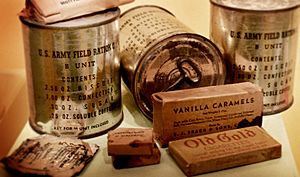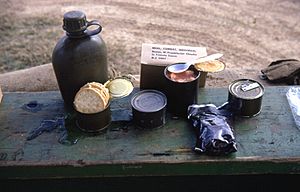C-ration facts for kids
The C-Ration, also known as the Field Ration, Type C, was a special meal packed in cans for soldiers in the United States military. It was given to troops when they couldn't get fresh food or meals prepared in a kitchen. C-Rations were designed to be eaten in the field, especially during combat.
Development of these rations started in 1938. They were first tested in 1940 and soon became widely used. Soldiers often called them "C-Rations" even after they were officially replaced in 1958 by the Meal Combat Individual (MCI). The MCI was very similar to the original C-Ration. Later, in the early 1980s, the MCI was replaced by the MRE, which is still used today.


Contents
Original C-Ration (1938–1945)
The first C-Ration was created to replace an older type of emergency food. Its goal was to be tastier, healthier, and last longer.
The early C-Ration meals came in two main parts:
- A 'meat' unit (M-unit)
- A 'bread-and-dessert' unit (B-unit)
Each soldier's daily food supply included six cans: three M-units and three B-units. This meant one M-unit and one B-unit for each meal.
Cans and Packaging
The first C-Ration cans were oblong, but they were soon changed to a more common round shape in 1939. These cans were about 4.4 inches (11 cm) tall and 3 inches (7.6 cm) wide. They were made of tinplate and had a special strip that could be opened with a key. A key was soldered to the bottom of every B-unit can.
At first, the cans had a shiny finish, but this was changed to a gold color to prevent rust. Later, during the war, the cans became drab green. This green color stayed the standard for many years, even for the C-Ration's successor.
Soldiers often wished for flat, rectangular cans because they were easier to pack. However, this wasn't possible due to a lack of machines that could make them.
Early C-Ration cans only had paper labels. These labels often fell off, making it a surprise what meal you would get! This made it hard for soldiers to trade for meals they liked better.
Soldiers' Opinions
Overall, soldiers in World War II didn't love the C-Rations. They found the cans heavy and hard to carry. The meals also became boring quickly. There were also differences in taste because many companies made the rations.
Even though C-Rations were meant for short-term use, soldiers sometimes had to eat them for weeks. By 1943, experts suggested that soldiers shouldn't eat C-Rations for more than five days in a row without other food.
Even after the official end of C-Ration production in 1958, old supplies were still given to troops. Some soldiers in the Vietnam War (as late as 1968) even received C-Rations from the early 1950s.
"M" Unit (Meat Unit)
The M-unit contained a canned main dish, usually made of beef and pork with spices and onions. Initially, there were three types:
- Meat Stew with Beans
- Meat with Vegetable Hash
- Meat Stew with Vegetables (carrots and potatoes)
These meals were chosen because they were similar to what soldiers usually ate in army dining halls.
Later, more meal options were added to make the rations less boring. These included "Meat & Spaghetti in Tomato Sauce," "Chopped Ham, Egg, and Potato," and "Frankfurters and Beans." Some unpopular meals, like "Meat Hash" and "Mutton Stew," were removed. However, "Ham and Lima Beans" remained a standard meal, even though many soldiers disliked it.
"B" Unit (Bread and Dessert Unit)
The B-unit provided crackers, sugar tablets, and energy tablets. It also included a drink mix like instant coffee, lemon drink (which had vitamin C), or soup powder. Later, orange, grape, and sweetened cocoa drink powders were added, all with Vitamin C.
In 1941, the energy tablets were replaced with loose candy, such as candy-coated peanuts or caramels. Due to spoilage, the loose candy was replaced in 1944 with a chocolate disk or a cookie sandwich.
A new B-unit with pre-mixed oatmeal cereal was introduced in 1944. This was usually served as a breakfast meal.
Accessory Pack
Soldiers also received an accessory pack with extra items. This pack was wrapped in brown paper and contained:
- Sugar tablets
- A flat wooden spoon
- A piece of candy-coated chewing gum
- Small packs of commercial cigarettes (this was common at the time, but smoking is not encouraged today)
- A book of matches
- A paper-wrapped P-38 can opener with instructions
- Toilet paper
The P-38 can opener was a small, simple tool that soldiers often kept on their dog tag chain to open their cans easily.
In 1945, the accessory pack was changed. Water purification tablets were removed, and salt tablets were added. To reduce waste, the pack was split into a "short" pack (with cigarettes and matches) and a "long" pack (with other accessories).
Crates
The C-Rations were packed in small wooden crates. Each crate weighed about 40 pounds and held enough food for 8 soldiers for one day (24 meals total).
Later C-Ration Versions (1946–1958)
After World War II, there was an attempt to create a new ration called the E-ration. It tried to combine the best parts of the C-ration and the K-ration. However, the bread in the E-ration was not tasty, so it was quickly stopped.
Because of this, planners decided to go back to the C-ration name, but they kept making small changes to the menus and items.
Revised C-Rations (1948–1958)
The C-2 ration, introduced in 1948, was designed to feed soldiers for up to three weeks continuously. It had five different menus. Each menu included an accessory packet with basic hygiene items, tobacco, and sweets.
In 1951, the C-3 ration offered even more variety with 10 different meat entrees. It was quite heavy, weighing about 5.5 pounds (2.5 kg) for a day's supply. It came in 8 small cans packed in a cardboard box.
The C-3 ration included:
- Three "M" (meat) components with different meals like Chopped Eggs and Ham or Pork and Beans.
- Three "B" (bread) components with crackers, instant coffee, powdered milk, sugar, cookies, and jam.
- A can of fruit.
- A sundries can with the accessory packet (chewing gum, toilet paper, P-38 can opener, salt, spoon) and a cigarette packet.
The C-3 ration was more nutritious than the original C-ration.
In 1954, the C-4 ration was introduced as a change to the C-3. It included two smaller cans of fruit instead of one large one. It also contained items like cheese bars, cereal bars, chocolate bars, jelly bars, and Fruit cake bars.
The End of C-Rations
When C-Rations were first introduced, they were only meant for short-term use, no more than three days. However, during the war, they were often used for much longer.
After the war, despite complaints about the meals being boring, the military decided to keep the C-Ration as the main packaged food for troops. They didn't develop new, lighter options. This meant soldiers often had to carry heavy canned meals, even when marching long distances.
The heavy C-Rations were a big problem during the Vietnam War. American soldiers sometimes put their cans in socks to make them quieter and easier to carry, while their enemies carried much lighter dry rice. This led to the quick development of the LRP ration (Long Range Patrol ration) in 1966, which was a lighter, dehydrated meal.
Starting in 1958, C-Rations were slowly replaced by the very similar canned Meal Combat Individual (MCI). These MCI rations were used for over two decades until they were replaced by the Meal Ready to Eat (MRE) in the early 1980s.
Influence
The C-Rations used during the Korean War later led to the introduction of instant coffee in South Korea.
Images for kids
See also
 In Spanish: Ración C para niños
In Spanish: Ración C para niños



